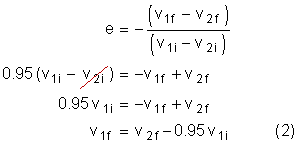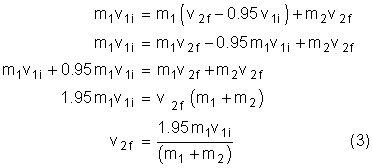Prerequisites
Students should have a basic understanding of vector and scalar quantities, and should be able to define kinetic energy qualitatively and algebraically. Students should also have an understanding of conservation of momentum and equation manipulation.
Learning Outcomes
In this lesson you will learn about the elasticity of a collision and the conservation of kinetic energy. Students will be able to define, compare and contrast elastic and inelastic collisions. Students will also be able to compare vector and scalar conservation laws and predict the results of a collision using these conservation laws.
Instructions
Students should know how the applet functions, as described in Help and ShowMe. The applet should be open. The step-by-step instructions on this page are to be done in the applet. You may need to toggle back and forth between instructions and applet if your screen space is limited.
In a previous lesson you looked at something called momentum. As you remember, momentum is a vector. In this lesson, however, we will be focusing on a scalar quantity - kinetic energy. We will investigate the role of kinetic energy in collisions and decide whether it is also conserved. But before we look at collisions and kinetic energy, let's review momentum and kinetic energy.
1D Collisions and Kinetic Energy
Kinetic energy is energy of motion. Any object that is moving not only has momentum, but also has kinetic energy. In previous lessons, you discovered that the total momentum of a closed, isolated system is conserved during a collision. But, what about kinetic energy - is it also conserved? Use the applet to help you answer the following questions. On the applet, un-check Show CM and Show CM Frame.
Do not worry about what e represents - this will be discussed later. The
value of e will be listed with the other applet information.
|
Collision 1 e
= _____
|
|||||||
|
Object
|
mass
(kg) |
vinitial
(m/s) |
vfinal
(m/s) |
pinitial
(kg·m/s) |
pfinal (kg·m/s) |
Ek initial (J) |
Ek final (J) |
|
Blue
|
|
|
|
|
|
|
|
|
Green
|
|
|
|
|
|
|
|
| Total | --- | --- | --- | ||||
|
Collision 2 e
= _____
|
|||||||
|
Object
|
mass
(kg) |
vinitial
(m/s) |
vfinal
(m/s) |
pinitial
(kg·m/s) |
pfinal (kg·m/s) |
Ek initial (J) |
Ek final (J) |
|
Blue
|
|
|
|
|
|
|
|
|
Green
|
|
|
|
|
|
|
|
| Total | --- | --- | --- | ||||
|
Collision 3 e
= _____
|
|||||||
|
Object
|
mass
(kg) |
vinitial
(m/s) |
vfinal
(m/s) |
pinitial
(kg·m/s) |
pfinal (kg·m/s) |
Ek initial (J) |
Ek final (J) |
|
Blue
|
|
|
|
|
|
|
|
|
Green
|
|
|
|
|
|
|
|
| Total | --- | --- | --- | ||||
|
Collision 4 e
= _____
|
|||||||
|
Object
|
mass
(kg) |
vinitial
(m/s) |
vfinal
(m/s) |
pinitial
(kg·m/s) |
pfinal (kg·m/s) |
Ek initial (J) |
Ek final (J) |
|
Blue
|
|
|
|
|
|
|
|
|
Green
|
|
|
|
|
|
|
|
| Total | --- | --- | --- | ||||
|
Collision 5 e
= _____
|
|||||||
|
Object
|
mass
(kg) |
vinitial
(m/s) |
vfinal
(m/s) |
pinitial
(kg·m/s) |
pfinal (kg·m/s) |
Ek initial (J) |
Ek final (J) |
|
Blue
|
|
|
|
|
|
|
|
|
Green
|
|
|
|
|
|
|
|
| Total | --- | --- | --- | ||||
In a collision, momentum is always conserved, but not kinetic energy. Sometimes,
the kinetic energy is nearly conserved and in other collisions, it is hardly
conserved at all. What is going on? To answer this question, we must consider
is happening to the objects during a collision.
Elastic and Inelastic Collisions
During a collision, energy changes form. As objects interact and collide, they change shape and are distorted. As this occurs, the kinetic energy of the colliding bodies is converted into potential energy, or dissipated as sound or heat. The extent to which energy is converted back to kinetic energy after the collision determines the "elasticity" of the collision.
There is a spectrum of elasticity: collisions can range from being perfectly elastic to perfectly inelastic. As collisions become more and more inelastic, less and less kinetic energy is conserved.
 |
|
Now that we have discussed the idea of elasticity, let's return to the collisions
you performed earlier. This time, we will look at what e represents.
|
Collision #
|
total initial kinetic energy
(J) |
total final kinetic energy
(J) |
% loss in kinetic energy
|
e |
|
1
|
|
|
|
|
|
2
|
|
|
|
|
| 3 | ||||
| 4 | ||||
| 5 |
In the previous question, you should have seen that as loss in kinetic energy increases, e becomes smaller and smaller. e is a measure of how much kinetic energy is lost during a collision - it is an indicator of the elasticity of the collision. By definition, e is the coefficient of restitution and is the ratio of the final velocities to the initial velocities of the colliding objects:

The value of e ranges from 1.0 to 0. For a perfectly elastic collision, e has
a value of 1.0. For a perfectly inelastic collision, e has a value of 0.
|
Elasticity of
Collisions
The coefficient of restitution,
e, is a measure of the elasticity of a collision. For a perfectly
elastic collision, kinetic energy is conserved and
|
We have now looked at two aspects of collisions: conservation of momentum and elasticity. We saw that in any collisions, momentum is always conserved (as long as there are no external forces acting on the system). Kinetic energy, however, is not always conserved - the elasticity of the collision is our clue to how much kinetic energy is conserved. These two pieces of information about a collision provides us with greater ability to analyse collisions and predict their outcomes.
In this section you will use both sets of equations to solve questions about collisions. These questions require several steps, but if you work carefully and follow a systematic approach (like the four-step method), they are easy to solve. For every question, use the applet to help you visualise the question and check you answer. Let's do an example together first
Example:
Object 1, with a mass of 3.0 kg, is travelling to the right at 6.1 m/s. It collides with object 2 which is at rest and has a mass of 8.0 kg. If e = 0.95, what is the final velocity of each object?
Solution:


 |
 |



Now, it is your turn! For each question, assume that the collisions are head-on and that the system is a closed, isolated system.
In this lesson you looked at the total kinetic energy of a system before and after a collision. You discovered that kinetic energy is not always conserved in a collision. The key points covered in this lesson are:
